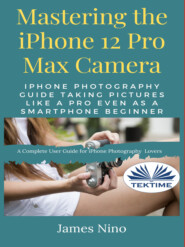
Полная версия:
Mastering The IPhone 12 Pro Max Camera

Mastering the iPhone 12 Pro Max Camera
iPhone Photography Guide Taking Pictures like a Pro Even as a SmartPhone Beginner
James Nino
© 2020 James Nino
All rights reserved.
This book or any portion thereof may not be reproduced or used in any manner whatsoever without the express written permission of the publisher except for the use of brief quotations in a book review.
You are welcome to join the Fan’s Corner, here
Mastering the iPhone 12 Pro Max Camera
iPhone Photography Guide Taking Pictures like a Pro Even as a SmartPhone Beginner
James Nino
Disclaimer
The advice and strategies found within may not be suitable for every situation. This work is sold with the understanding that neither the author nor the publisher is held responsible for the results accrued from the advice in this book.
All rights reserved. No part of this publication may be reproduced, distributed, or transmitted in any form or by any means, including photocopying, recording, or other electronic or mechanical methods, without the prior written permission of the publisher, except in the case of brief quotations embodied in critical reviews and certain other noncommercial uses permitted by copyright law.
Introduction
Hey, congratulation on purchasing Mastering the iPhone 12 Pro Max Camera book. This book is a must-have book for anyone who wants to use his or her iPhone 12 Pro Max to start taking stunning photos.
This book will open your eyes to many of the basic functions that the iPhone 12 Pro Max camera can be used for as well as some advanced functions that may not be too obvious to users of the iPhone 12 Pro Max. For those who already have older versions of the iPhone and have difficulty locating some of their favorite icons, this book will show you where they have been moved to and the most effective ways of using them to take amazing pictures.
Quite often, the manuals shipped with our devices tend not to do enough justice to the subject of the device at other times, they can be overwhelming. Many other “Get Started Guides” are sometimes too thin and do not really solve any problem, which is why this book is a real gem.
This book will get you acquainted with the mobile phone you carry around you that you can also use as your photography device whenever you go on a trip, attend an event, visit a location, or casting a scene. Knowing how to get more from the digital camera in your pocket is what this book is about, after all, after spending so much to get your iPhone 12 Pro Max, you naturally would want to get more out of it.
This book will help you know how to use the camera on your iPhone 12 Pro Max better and help you optimize the camera features in a lot more ways than you have ever imagined.
As you open the pages of this book, you will be exposed to a wide range of fantastic photos and video tools that you had probably overlooked as ordinary symbols to a position where you now know how to use them. Not only that, you will be shown how to use the iPhone to video a full wedding ceremony. Lovers of drones will also find a chapter of this book where using the iPhone 12 Pro Max with drones is discussed. Overall, this book tries to cater for everyone including social media freaks.
For those who order this book while on vacation, this book can help you improve on your use of your iPhone camera, especially for those things you did not know it could do. You will find that this book is quite worth the time and money spent on it and highly recommended to anyone who uses their iPhone 12 Pro Max to take pictures.
You can start using your iPhone 12 Pro Max camera and start taking the kind of photos that nobody will even believe were shot by you with an iPhone. If you haven’t got your copy and are still hesitating, you should be click the “Buy Now” button to get yours now.
Contents to Expect
Chapter 1
Introducing the iPhone 12 Pro
Design of the iPhone 12 Pro Max Camera
iPhone 12 Pro Max Cameras
Ultra-Wide Camera
Wide Camera
Telephoto Camera
Versatility of the Camera System
Augmented Reality (AR) for Innovative Camera Usage
iPhone 12 Pro Max Tech Specs
The iPhone 12 Pro Max’s Technical Specs
The iPhone 12’s Pro Design and Display
iPhone 12 Pro Max Camera
iPhone 12 Pro Max HDR Feature
Utilizing the HDR Mode On iPhone 12 Pro Max
Technically Defining HDR
Chapter 2
About the Apple iPhone 12 Pro Max Camera
Apple iPhone 12 Pro Max Camera Features
Relevant Camera Settings to Know
Focus
Exposure
Filters
Self-Timer
High Dynamic Range (HDR)
Rule of Thirds
The Golden Ratio
DSLR VS iPhone 12 Pro Max
Who is the iPhone 12 Pro Max Suited for
Chapter 3
Capturing Photos on iPhone 12 Pro Max
iPhone 12 Pro Max Camera Modes
Photo Mode
Portrait Mode
Pano Mode
Video Mode
Slo-Mo Mode
Time-Lapse Mode
Exploring The iPhone 12 Pro Max Lenses
Switching Between the Lenses
Switching to the Standard Wide-Angle Lens
Switching to the Ultra-Wide-Angle Lens
Switching to the Telephoto Lens
Fine Tuning the zoom in and Out
To zoom on the iPhone 12 Pro Max
Another way to Operate the Zoom Feature
Zoom Out Photos After Shooting
Expanding your Photoshoot Scene
Introducing the LIDAR Sensor
Using the Volume Buttons as a Shutter
Quick Take Using the iPhone 12 Pro Max Volume Button
Taking Pictures with the Rear Cameras
How to Record Videos
Recording a Video Between Photos Using QuickTake
Taking Burst Photos
Setting Up Photo Capture Outside of the Frame
Taking Advantage of Outside the Frame
Scanning QR Codes with your iPhone
Expanding the Capability of the Front Camera
Mirroring Front Camera
Chapter 4
Manipulating Images on iPhone 12 Pro Max
Editing a Photo or Video
Before and After Effects of Photo Edits
Take Screenshots
Knowing the Different Cropping Options
Straightening and Adjusting Perspective
How to Use Filters Correctly
Taking a Photo with a Filter
Applying Filter Effects on a Photo
Marking Up a Photo
Trimming a Video
Reverting to an Original Photo or Video
Changing the Aspect Ratio
Shooting with the Ultra-Wide Lens
Indicator for Camera Rolling
Chapter 5
Additional Controls on the Camera App
Learn to Take Great Selfies All by Yourself
Selfie Cameras
Taking a Selfie
Taking a Slofie
Switching Between Close and Wide-Angle Selfies
Utilizing the Night Mode
Live Photos and Having Fun with Them
Taking a Live Photo
Editing a Live Photo
To Edit Live Photos
Viewing a Live Photo
Viewing Custom Effects of a Live Photo
Types of Live Photo Effects
Live
Loop
Bounce
Long Exposure
Taking a Panorama Photo
Slow Motion Video
Recording a Slow-motion Video
Understanding iPhone 12 Pro Max Camera Focus
Adjusting the Camera Focus
Manually Adjusting the Camera Focus
Understanding iPhone 12 Camera Exposure
How to Adjust the Camera Exposure
How to Lock Camera Focus and Exposure Separately
How to Use the Self-Timer
Steps to Accessing and Using the Self-timer
Having Fun with Your iPhone 12 Pro Max
How to Create your Own Memoji
To Edit, Duplicate, or Delete a Memoji
Sending Animated Animoji or Memoji Recordings
Chapter 6
Configuring Other Camera Settings
Accessing Hidden Camera Controls
Using the HDR Feature
The Portrait Mode on iPhone 12 Pro Max
Blurring Photos Backgrounds with Portrait Mode
Adjusting Portrait Photos
How Not to Include the Blur
Low-Light Photography
Low-Light Photos with Night Mode
Chapter 7
Getting the Most of Your iPhone 12 Pro Max
Best Practices for Smartphone Photography
i. Always Look for Light
ii. Focus and Exposure Adjustment
iii. Making Use of HDR Mode
iv. Turning on Grids
v. Burst Shots
vi. Try Close Focusing
vii. Get Used to Your Default Camera App
viii. Try Add-On Lens
ix. Editing Photos
Chapter 7
iPhone 12 Videography
Video Quality
How to Shoot Videos with your iPhone 12
Time-Lapse Videos
Professional iPhone 12 Pro Max Videos
Image Stabilization
Dolby Vision
How to Turn-on Dolby Vision in Video Recording
Drone Photography with the iPhone 12
Wedding Photographs with the iPhone 12
Chapter 8
Third-party Camera Apps
Camera+ 2
Obscura 2
VSCO
Halide
ProCamera
Caring for Your iPhone Camera
Conclusion
Chapter 1
Introducing the iPhone 12 Pro

Apple in October of 2020 announced its iPhone 12s’ line up, ranging from iPhone 12, iPhone 12 Pro, and iPhone 12 Pro Max. All these smartphones are the best phones you are going to find in the market.
Apple is known for its quality products and they have not disappointed their fans this time too. Everything in the smartphone is at its best. Though Apple had to face critics for not giving a charging adapter along with the smartphones, Apple still managed to satisfy their fans with the awesome design and quality.
The build of the iPhone 12 series reminds us of the iPhone 5s. The sharp cut edges that seem to have been abandoned in subsequent releases after the iPhone 5s was reintroduced in this iPhone and has been the talking point of the phone since then and appreciated by millions of iPhone fans all over the world. It is hard to get your eyes off the attractive form of the phone and the camera set up that characterizes all three phones.
Apple announced everything regarding the cameras in the official event held in October. Guess what; this time, iPhone cameras have added more features than ever experienced in an iPhone.
The stunning features and quality capture have even impressed professional photographers. If you are already from an iPhone family, then you might be aware of the quality of pictures. This time in iPhone 12 series, the inclusion of telephoto lenses has made fans crazy for it.
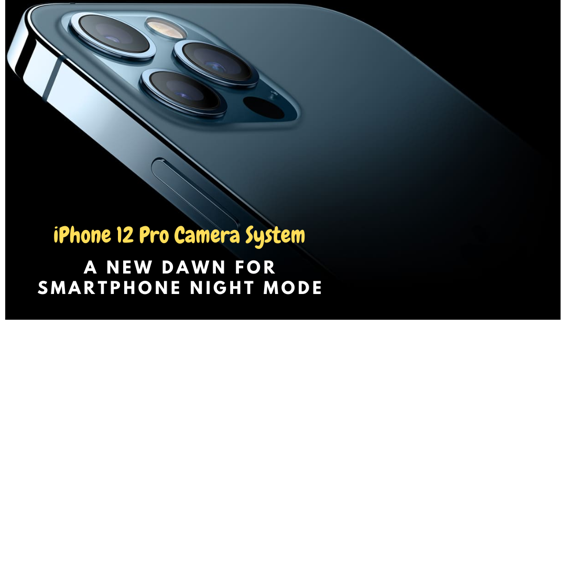
Figure 1: iPhone 12 Pro Max Lenses
Even though the whole lineup of the iPhone 12 series has got the best of the cameras in their respective segments, however, the iPhone 12 Pro Max has got such remarkable features that serious lovers of photography admire. Being a photography enthusiast, I tend to prefer the iPhone 12 Pro Max camera among the three, mostly because of its size and shape.
The camera setup is incredibly better than previous iPhones and best suits the design of the smartphone body. Be it tapping the low light photos or zooming the street captures; everything is up to mark.
Who doesn't love night portraits? The iPhone 12 Pro Max camera is able to take some of the best night portraits ever taken by a phone camera with its portrait mode. The telephoto lens helps you capture scenes with very little detail. Apple is known for its quality products and they have continued their tradition of quality in this iPhone 12 Pro Max.
Well, you all might be thinking that why am I highlighting iPhone 12 Pro Max cameras again and again. Guys, the iPhone 12 Pro Max's camera have got exceptional features. You can record more spectacular videos using iPhone 12 Pro Max, as it comes equipped with a Dolby vision recording that has 60 times more colors. I would be telling you in detail everything that makes iPhone 12 Pro Max's camera the best in the market right now. If you want to make the best of your iPhone 12 Pro Max cameras, then stick with me to the end of this book.
Using the iPhone 12 Pro Max to take pictures is as easy as it's always been in previous versions of the iPhones only that now you can make it do more than those versions if you only knew how to find your way around the interface. Compared to what you may be used to in earlier versions of the iPhone, some controls and settings in the iPhone 12 Pro Max no longer exist while many others have been moved to new locations, including some changes in the layout of the phone’s camera app. The camera app on the iPhone 12 Pro Max is at first glance similar to the old iPhone Camera app only that the new app has a great deal of depth, which makes it able to take crisp photos with minimal effort even when the lighting is limited.
Software and interface changes are not the only things that differentiate the iPhone 12 Pro Max from other iPhone versions. The cameras on the iPhone were already very good at taking great daytime pictures, but the new iPhone 12 Pro Max takes their photography to a whole new level. This is mostly because of the triple-lens setup at the back of the iPhone 12 Pro Max and the supersonic A14 Bionic that enables the phone to expand its capabilities.
To take advantage of these hardware features is an expanded new iOS 14 operating system that enables it to produce crystal clear pictures, among other new functions like the Night mode on all lenses and the Quick Take video. There is also a unique feature that allows users to zoom out on an image even though you had previously captured it with some parts that seem to be missing.
These hardware and software make the iPhone 12 Pro Max to be touted to be one of the best iPhones ever to be produced by Apple when you consider the ingenuity in combining technology with the phone’s high-level photography. The majority of the iPhone’s 12 Pro functions involve knowing what and how to tap, which is what helps to ensure that the photos shot with the iPhone 12 Pro Max even if taken by a novice come out crisp, amazing and sharp. This phone runs on iOS 14 with a high-level dual-sensor for the rear cameras and is also powered by Apple’s new A14 Bionic chip.
The four available colors for the iPhone 12 Pro Max for buyers to choose from include pacific blue, gold, graphite, and silver.
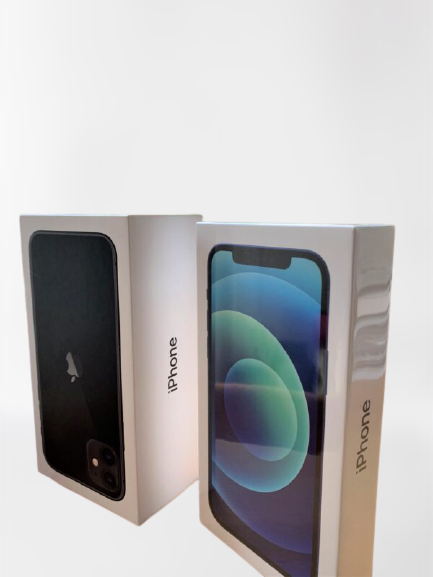
Figure 2: Unboxing the iPhone 12 Pro Max
According to Apple, the iPhone 12 Pro Max is made from the toughest glass ever to grace the glass body of a smartphone and offers an amazing resistance to dust and water with its IP rating of IP68, which helps to improve its reliability and durability.
It's rated to be able to stay up to a depth of water of up to 2M or 6.5 feet for a period of up to 30 minutes. Although an IP68 rating can withstand immersion in water, it is advisable to limit the phone’s exposure to water to just splashes, accidental exposure to liquid, and maybe rain.
For sounds, it equally supports Dolby Atmos and Spatial audio, which enables it to offer a truly impressive sound experience.
Design of the iPhone 12 Pro Max Camera
The iPhone 12 series is totally for photos and videos. The sharp design of the device and those three camera lenses along with the LIDAR sensor will surely win your heart. The camera lenses are installed on the top-left corner of the rear side as they were in iPhone 11 pro max.
iPhone 12 Pro Max Cameras
There are 3 cameras on the iPhone 12 Pro Max, including a flashlight and LIDAR Scanner. These cameras include an Ultra-wide camera, a telephoto camera, and a wide camera. These cameras have a 7x zoom and focus lens to make the shots better. Let us have a look at their features and their functions.
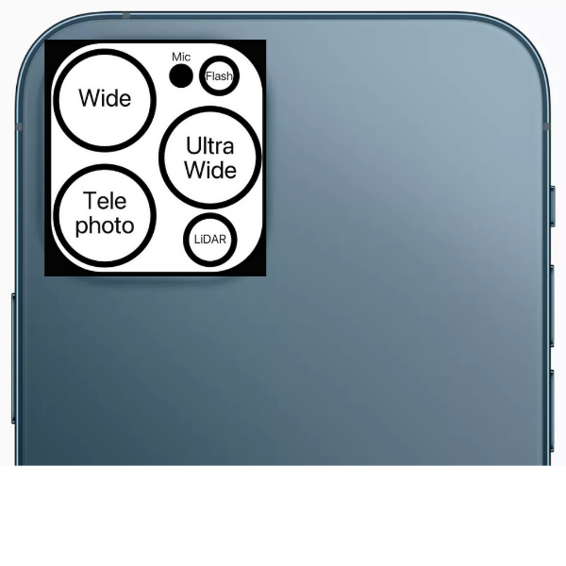
Figure 3: iPhone 12 Pro Max Layout
Ultra-Wide Camera
The ultra-wide camera has a 120-degree field of view that helps you in capturing extra-wide-angle shots.

Figure 4: Identifying the 12MP Ultra-wide Lens
Wide Camera
The wide camera has a 7-element lens with Sensor-shift optical image stabilization and 100 focus pixels.
.

Figure 5: Identifying the 12MP Wide Lens
Telephoto Camera
The telephoto camera is for taking stunning portraits and square pictures. It consists of a 6-element lens.
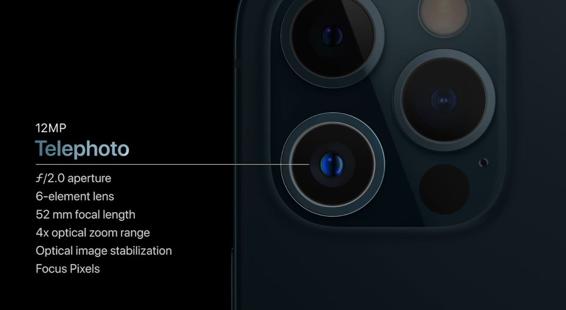
Figure 6: Identifying the 12MP Telephoto Lens
The neat and clean design of the iPhone 12 Pro Max makes it look elegant. The cameras are placed in the same position as the iPhone 11 Pro Max, but when compared with the iPhone 11 Pro Max; iPhone 12 Pro Max has a bigger image sensor, a faster main camera lens, and better image stabilization. Autofocus also has an improvement with the LIDAR sensor.
Versatility of the Camera System
The camera hardware is powered by the super A14 Bionic with a new image signal processor, which helps in improving image quality and other popular photography features that are not possible with general cameras. It also includes the Apple Pro Raw, which allows users to exercise better control over colors, details, and dynamic range on the iPhone or other photo editing apps.
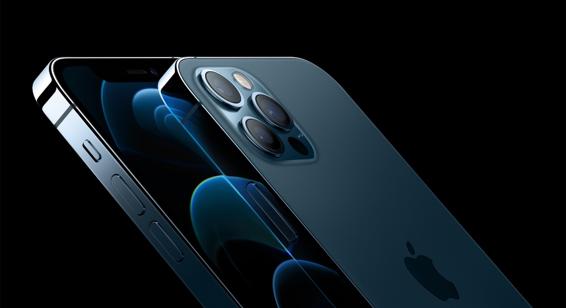
Figure 7: iPhone 12 Rear Cameras
The iPhone 12 Pro Max also offers the best quality video shooting through its end-to-end HDR video with Dolby vision up to 60 FPS and comes with better stabilization. Well, more about this will be discussed when we dive more into the video capabilities of the iPhone in the videos section.
Augmented Reality (AR) for Innovative Camera Usage
The new LIDAR scanner measures light distance and makes use of pixel depth information of a view. This helps in faster and more realistic, as well as reliable AR experiences, and also improves autofocus by 7x in low lights for more accuracy and reducing the capture time of the photos. This amazing LIDAR scanner unlocks various night mode portraits, which help in rendering a low light Bokeh effect. This feature has also resulted in programmers creating various apps that take advantage of this innovative feature to create apps that can measure distances between two points.
iPhone 12 Pro Max Tech Specs
Apple has brought a lot of new exciting features and hardware changes in its most recent lineup. If you are someone who is switching from Android to iPhone 12 Pro Max or an existing iPhone user and finding it hard to get used to these newly introduced changes in tech specs and design of iPhone 12 Pro Max, let me walk you through all the new changes - technical aspects and specifications.
The iPhone 12 Pro Max’s Technical Specs
The iPhone 12 Pro Max is the biggest, heaviest, and most expensive iPhone to be released by Apple so far. It comes with a 6.7-inch touchscreen shipped with the iOS 14 and powered by a hex-core Apple A14 Bionic CPU. As at the time of writing this book, this processor is acclaimed to be Apple’s fastest chip in the market which allows it to give the iPhone 12 its superior performance and support for the graphical demands of the iPhone 12 Pro Max.
The iPhone 12 Pro Max features dual GSM SIMs for Nano-SIM and eSIM cards.
The iPhone 12 Pro Max is a pioneer in its supports for the 5G technology, which is the fastest technology compared to the iPhone 11 Pro’s support for the 4G LTE network. This is one of the main features with which no other phone can be compared with the iPhone 12 series.
The Intel modem chip that comes with iPhone 12 Pro Max supports Gigabit-class LTE, 802.12 a/b/g/n/ac Wi-Fi 6 support, Band 40 support, Bluetooth 5.0, and UI ultra-wideband chip for better spatial awareness with better indoor tracking capabilities. It also has sensors that it uses for its gyroscope, ambient light sensor, accelerometer, compass/ magnetometer, barometer, and proximity sensor. Not to be left out is its support for face unlocks with 3D face recognition.
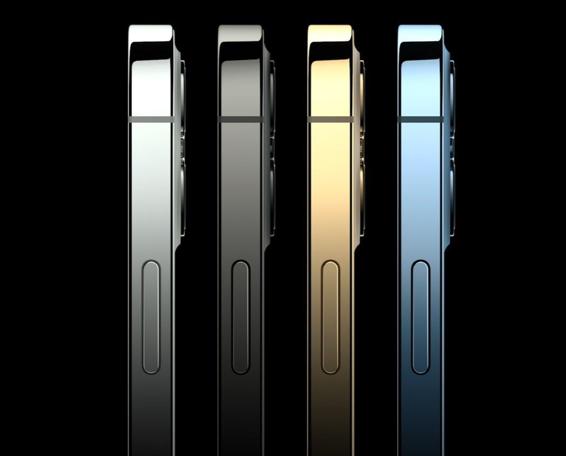
Figure 8: Various Colors for Shipping iPhone 12
The iPhone 12 Pro Max has support for Qi wireless charging, including proprietary MagSafe fast charging.
The battery life of the iPhone 12 Pro Max is terrific and is powered by a non-removable 2815mAh battery.
The iPhone 12’s Pro Design and Display
The iPhone 12 Pro Max shares similar physical attributes as its predecessor iPhone 5s but has a noticeable camera bump on its back that houses the triple camera array, which is not present on the iPhone 5s but was introduced in the iPhone 11 series.



